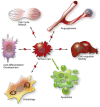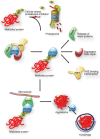HDAC inhibitor-based therapies: can we interpret the code?
- PMID: 23141799
- PMCID: PMC5528347
- DOI: 10.1016/j.molonc.2012.09.003
HDAC inhibitor-based therapies: can we interpret the code?
Abstract
Abnormal epigenetic control is a common early event in tumour progression, and aberrant acetylation in particular has been implicated in tumourigenesis. One of the most promising approaches towards drugs that modulate epigenetic processes has been seen in the development of inhibitors of histone deacetylases (HDACs). HDACs regulate the acetylation of histones in nucleosomes, which mediates changes in chromatin conformation, leading to regulation of gene expression. HDACs also regulate the acetylation status of a variety of other non-histone substrates, including key tumour suppressor proteins and oncogenes. Histone deacetylase inhibitors (HDIs) are potent anti-proliferative agents which modulate acetylation by targeting histone deacetylases. Interest is increasing in HDI-based therapies and so far, two HDIs, vorinostat (SAHA) and romidepsin (FK228), have been approved for treating cutaneous T-cell lymphoma (CTCL). Others are undergoing clinical trials. Treatment with HDIs prompts tumour cells to undergo apoptosis, and cell-based studies have shown a number of other outcomes to result from HDI treatment, including cell-cycle arrest, cell differentiation, anti-angiogenesis and autophagy. However, our understanding of the key pathways through which HDAC inhibitors affect tumour cell growth remains incomplete, which has hampered progress in identifying malignancies other than CTCL which are likely to respond to HDI treatment.
Copyright © 2012 Federation of European Biochemical Societies. Published by Elsevier B.V. All rights reserved.
Figures



References
-
- Arts, J. , Angibaud, P. , Marien, A. , Floren, W. , Janssens, B. , King, P. , van Dun, J. , Janssen, L. , Geerts, T. , Tuman, R.W. , Johnson, D.L. , Andries, L. , Jung, M. , Janicot, M. , van Emelen, K. , 2007. R306465 is a novel potent inhibitor of class I histone deacetylases with broad-spectrum antitumoral activity against solid and haematological malignancies. Br. J. Cancer. 97, 1344–1353. - PMC - PubMed
-
- Badros, A. , Burger, A.M. , Philip, S. , Niesvizky, R. , Kolla, S.S. , Goloubeva, O. , Harris, C. , Zwiebel, J. , Wright, J.J. , Espinoza-Delgado, I. , Baer, M.R. , Holleran, J.L. , Egorin, M.J. , Grant, S. , 2009. Phase I study of vorinostat in combination with bortezomib for relapsed and refractory multiple myeloma. Clin. Cancer Res. 15, 5250–5257. - PMC - PubMed
-
- Bakkenist, C.J. , Kastan, M.B. , 2003. DNA damage activates ATM through intermolecular autophosphorylation and dimer dissociation. Nature. 421, 499–506. - PubMed
-
- Balch, W.E. , Morimoto, R.I. , Dillin, A. , Kelly, J.W. , 2008. Adapting proteostasis for disease intervention. Science. 319, 916–919. - PubMed
Publication types
MeSH terms
Substances
Grants and funding
LinkOut - more resources
Full Text Sources
Other Literature Sources

